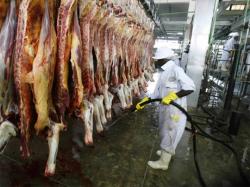Statement Of The American Meat Institute On Beef Safety
March 24, 2010 | 3 min to read

Washington, D.C. Producing meat that is as safe as we can make it is the
industrys number one priority. Federal inspectors are present in our plants
every day to ensure that we are operating in compliance with federal rules and
that the technologies we use to destroy bacteria are working to ensure that only
safe and wholesome products enter the marketplace.
Our enemy is pathogenic bacteria and these bacteria respond to scientific
interventions, not regulatory bans. The food safety strategies in place in
plants today are far more effective in enhancing food safety than outlawing a
pathogen that nature presents us.
For two decades, the industry has used Hazard Analysis and Critical Control
Point (HACCP) plans that require plants to analyze what problems might occur and
then put in place ways to prevent those problems. We believe so strongly in
HACCPs benefits that we petitioned the USDA to mandate HACCP for all federally
inspected plants. HACCP became mandatory for large plants in 1998, medium sized
plants in 1999 and small plants in 2000. As part of HACCP plans, plants use
hurdle strategies that are like roadblocks for bacteria throughout a plant. No
other industry has the level of regulation and inspection as the meat industry,
Unfortunately, technology does not yet exist to guarantee the elimination of E.
coli O157:H7 in raw agricultural products, including ground beef, but we are
getting close. Government data show that the industry has made great progress.
According to USDA, the prevalence of E. coli O157:H7 on raw ground beef has
declined by 63 percent since 2000 to a prevalence rate of one-third of one
percent. The Centers for Disease Control and Prevention data show those human
cases of E. coli O157:H7 from all sources not just meat have declined by 44
percent since 2000. Government estimates show that three illnesses per 100,000
population occur each year from the consumption of nearly 10 billion pounds of
ground beef. That is an occurrence of one illness per five million serving of
ground beef, which is far lower than many other foods we consume.
E. coli O157:H7 is considered an adulterant in non-intact beef products, such
as ground beef, which means that if the pathogen is found, the product cannot be
sold and if it is in the marketplace it must be recalled. Some groups have
raised concern about another strain of E. coli called non-O157 Shiga-toxin
producing E. coli or non-O157 STECs. Its important to note that there have
been no known outbreaks of non-O157 STECS associated with meat products in the
United States.
Consumers should be assured that the highly effective interventions currently in
place to control E. coli O157:H7 will also destroy non-O157 STECs. If a
regulatory change could destroy bacteria, we would be lobbying for it. But
changing a bacterias legal status wont make it disappear. Only preventative
food safety technologies will destroy pathogens. And the final food safety step
cooking ground beef to 160 degrees F. works equally well against various
strains of E. coli and a host of other bacteria, in the event that they are
present on meat.
We share the frustration of those who argue for a regulatory change because the
industry also wants to eliminate pathogens on all meat products. We spend
millions of dollars annually to achieve that goal. We simply believe that
science and technology offers a better solution than regulatory bans that wont
eliminate the pathogen.
Finally, we ask consumers to keep in mind that the industry benefits by selling
food that is as safe as we can possibly make it and we will continue to look for
new and better scientific strategies to improve meat safety.
Source:
American Meat Institute
